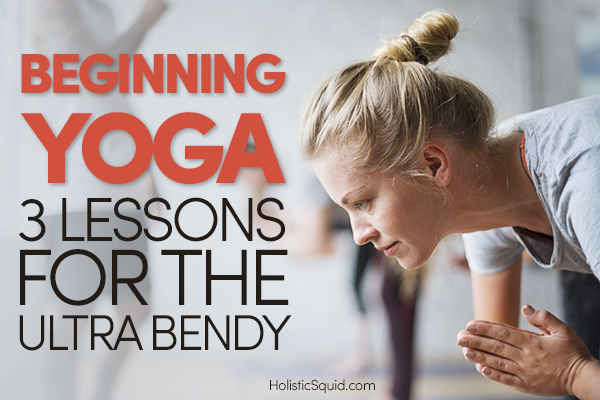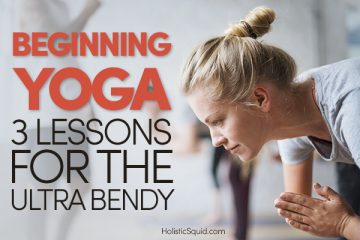

When beginning yoga in Philadelphia in the 90’s, there were no special outfits and way fewer gurus. We got together in converted garages and living rooms wearing old clothes to sweat, breathe, and find some inner peace.
It was during this time I learned how to stand up straight and quiet my mind by simply focusing on breath – two skills that have transformed my life for the better.
I also discovered that I was super bendy, something my inner competitive spirit valued. Let’s face it, while yoga isn’t meant to be a competitive sport, these days most Lululemon clad yogis are all secretly peeking to see if they are reaching the farthest or wrapping the deepest.
It was during one of these early classes, doing a simple seated forward bend pose, that I was faced with a predicament. At the edge of where I could comfortably stretch, should I reach further?
The pitfalls of flexibility when beginning yoga
Ridiculous as it now sounds, I decided that the sensation I felt in the back of my legs was my body opening to a new depth. I was rewarded with a strained hamstring, and a new-found understanding of my physical limits.
Being overly flexible can be a blessing and a curse. For me, my bendiness made me feel like I was ‘good at yoga,' so I enjoyed doing it even more. The down-side is that flexibility in yoga often encourages yogis and their teachers to push further to achieve what seems like better results. Unfortunately, this can also put undue strain on your ligaments and joints in the process.
The job of ligaments is to protect joints from overextending. Ligaments don’t have the same rebounding memory as muscle. Furthermore, when joints overextend, the bones can rub together triggering pain, impacting mobility, and often causing irreversible damage. (source)
While gentle yoga for flexibility is certainly beneficial, too much and too intense of a yoga practice can be extremely counterproductive.
As an acupuncturist, I often treat yoga enthusiasts for related strained wrists, neck pain, shoulder injuries, and sciatica. Hundreds of orthopedic surgeons link crippling arthritic hip damage (that often requires hip replacement) to middle-aged women who do yoga. (source)
Lesson #1: Yoga and competitiveness don’t mix
A few years into my yoga practice, I moved cross-country and was living in an Airstream trailer in Malibu. My newfound endless-summer high plus six days per week of Ashtanga yoga had me aspiring to new levels of yogic contortion.
In one class, we were taking a break from flowing poses to practice inversions. Being an ‘advanced’ yogi, I thought it was high-time to try scorpion pose (a forearm balance and backbend where your toes reach around to touch your arching head). My inner competitive yogi was squelched for good when I dropped with a crunch, and earned a back injury that would come back to haunt me for over a decade and a half.
Lesson #2: There's an extra risk for bendy chicks
According to long time yoga teacher, Charlotte Bell, and many other experts, women have a special liability when it comes to flexibility: relaxin.
Typically associated with pregnancy, relaxin is a hormone also produced every month around ovulation. It’s essentially a naturally occurring muscle relaxer and can cause joints to be looser and more at risk for injury.
Bell recommends that for women (and especially pregnant women) less is more:
You wouldn’t encourage a muscle-bound yoga student to lift more weights and stiffen up. Equally, a too-flexible student doesn’t benefit from becoming even more flexible. Too much flexibility is just as unhealthy is too much stiffness. Balance is what we’re going for in asana practice. Familiarize yourself with what normal range of motion looks like.
Lesson #3: Take responsibility for strength and alignment
Muscles, ligaments and tendons all work together to give your body proper alignment and support. When muscles are over-stretched and under-strengthened it puts pressure on the ligaments to keep pulling, eventually causing bone-on-bone issues. While most yoga classes naturally include strength-training, don’t take it for granted. If you are experiencing joint pain, you may need more muscle mass for support. (source)
Beyond strength, one of the most important things in yoga is proper alignment. I had done yoga for over ten years before my friend and therapeutic yogi master Rachelle Luczynski, pointed out that I had been hyper-extending in essentially every yoga pose for my entire yoga practice.
With yoga’s exponential popularity over the past ten years or so, there are new studios and teachers sprouting up everywhere. Classes get crowded and many teachers are either unexperienced or simply can’t micro-manage the alignment of all of their students at once.
With this in mind, it is your responsibility to protect and care for your body. Find an expert in alignment (perhaps an Iyengar class or a very attentive and experienced teacher) to educate yourself on how to protect your joints, and prioritize proper alignment and joint stability over bending further or pushing harder.
Whether you’re naturally flexible or can barely touch your toes, over-stretching can happen in a matter of a few split seconds. When it comes to stretching of any sort, err on the side of conservative and pull back if you feel discomfort or something just doesn’t feel right. If you don’t realize you’ve gone too far until you’re done with a workout, be sure to rest adequately to give your body time to recover.











Is there a way to start yoga in my home? I’ve never tired it but am fully aware of the growing yoga craze. With 3 kiddos and homeschooling…I’m assuming doing yoga in the morning is the best choice since I’m beat by nighttime. Is there a recommendated DVD or basic yoga techniques?
Hi Tanya, yes, yoga is incredibly good for you. I don’t have any recommendations but maybe some other readers have some for you…
Hi Tanya!
I am in a similar position to you (at home, but I only have one kiddo at the moment), and have found that there are lots of resources out there on YouTube that you can use for in-home practice. I purchased a package of classes at a local studio, and I get to go about once a week for “me-time,” while my husband takes care of our daughter. The other days, I have been practicing with various other yogis online. You can subscribe to their channels and pick out videos to practice with! Some of them even sort their videos by length so you can choose something based on how much time you have that day. There are subscription services out there too, but you can always start with the massive amounts of free content on YouTube to get an idea of the style of yoga that you like best. You could start with searching “beginning yoga” or “yoga for beginners” on YouTube.
Morning yoga is great, but evening yoga can be really great too–even if I’m tired to start with, I feel refreshed and really relaxed when I’m done, and I sleep really well.
Good luck with your yoga journey!